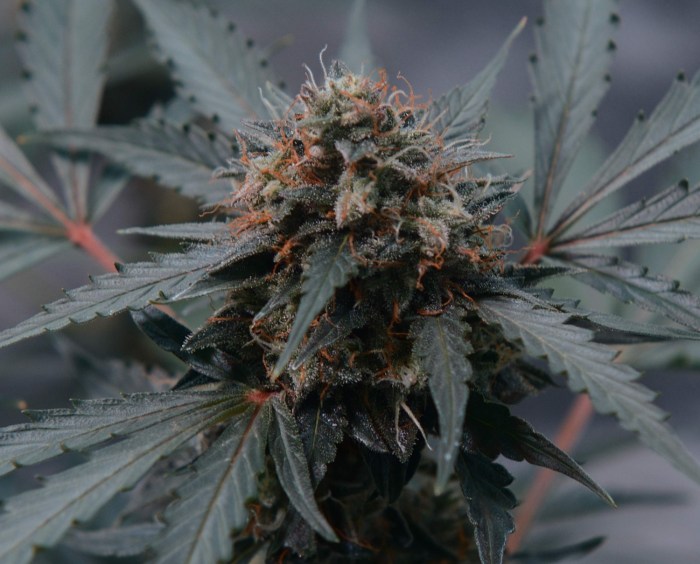White Widow Plant Description

White widow pot plant – White Widow is a renowned cannabis strain celebrated for its potent effects and distinctive appearance. Its origins remain somewhat shrouded in mystery, with various accounts suggesting its development in the Netherlands during the late 1980s or early 1990s, possibly through a cross between South Indian and Brazilian sativa strains. Regardless of its exact lineage, the resulting hybrid exhibits a unique combination of traits that have cemented its place among cannabis enthusiasts.White Widow’s morphology is characterized by a robust, bushy structure.
Its growth habit is typically indica-dominant, resulting in a compact plant with dense, resinous buds. This makes it a popular choice for indoor cultivation due to its manageable size and high yield potential. However, outdoor cultivation is also possible in warmer climates with sufficient sunlight.
Plant Dimensions and Leaf Structure
White Widow plants generally reach a height of 1 to 2 meters indoors, and can grow taller outdoors, reaching up to 2.5 meters depending on environmental conditions and growing techniques. The width is typically comparable to its height, creating a full, bushy plant. The leaves are broad, with a classic indica leaf shape—wide, short, and dark green, often with a slightly serrated edge.
Mature plants can exhibit a striking characteristic: the development of a thick layer of trichomes, giving the buds their characteristic “white widow” appearance. This abundance of trichomes contributes significantly to the strain’s high potency.
Flowering Characteristics and Unique Traits
White Widow’s flowering period typically lasts for 8 to 9 weeks. During this time, the buds develop a dense, compact structure, often exhibiting a frosty coating of trichomes that gives them a silvery-white appearance, hence the strain’s name. The aroma is often described as pungent, earthy, and slightly sweet, with hints of pepper and citrus. A unique characteristic of White Widow is its exceptionally high resin production, contributing to its potent THC content, typically ranging from 15% to 20%, though some phenotypes can exceed this range.
The high is generally described as a balanced blend of cerebral stimulation and physical relaxation, offering a potent and long-lasting effect. This balanced effect, combined with its high resin production and distinctive appearance, sets White Widow apart from many other cannabis strains.
The potent White Widow strain thrives in ample space. For optimal growth and yield, consider a sizable container; a robust 7 gallon plant pot provides the necessary root room for this demanding plant. This ensures the White Widow’s vigorous growth isn’t stunted, resulting in a healthier, more productive harvest.
White Widow Cultivation Techniques

Cultivating White Widow, a potent and popular cannabis strain, requires a careful understanding of its specific needs. Success hinges on providing the optimal environment for growth, from germination to harvest. This section details the essential techniques for maximizing yield and quality.
Optimal growing conditions are crucial for White Widow’s development. This includes careful management of light, temperature, humidity, and nutrients. Failure to meet these requirements can lead to stunted growth, reduced yields, and susceptibility to pests and diseases.
Light Requirements for White Widow
White Widow thrives under intense light. During the vegetative stage, 18-24 hours of light per day is ideal to promote vigorous growth. Switching to a 12/12 light cycle (12 hours light, 12 hours dark) triggers the flowering phase, initiating the development of buds. Supplemental lighting, such as high-intensity discharge (HID) lamps or LED grow lights, might be necessary, especially in indoor cultivation, to ensure sufficient light intensity and penetration.
The intensity and spectrum of light significantly influence the plant’s growth and yield.
Temperature and Humidity Control for White Widow, White widow pot plant
Maintaining a stable temperature and humidity level is paramount. The ideal temperature range for vegetative growth is between 70-80°F (21-27°C), while during flowering, a slightly cooler temperature of 65-75°F (18-24°C) is preferred. Relative humidity should be around 50-70% during vegetative growth and reduced to 40-50% during flowering to prevent mold and mildew development. Fluctuations in temperature and humidity can stress the plant, impacting its health and productivity.
Soil and Nutrient Needs for White Widow
White Widow benefits from well-draining soil rich in organic matter. A slightly acidic pH level of 6.0-6.5 is optimal for nutrient uptake. Nutrient requirements vary depending on the growth stage. During vegetative growth, focus on nitrogen-rich fertilizers to promote leaf growth. As the plant enters the flowering stage, shift to phosphorus and potassium-rich fertilizers to support bud development.
Over-fertilization can be detrimental, leading to nutrient burn, so careful monitoring and adherence to recommended feeding schedules are essential. Using high-quality soil and implementing a balanced fertilization strategy are key to achieving optimal results.
Cultivation Methods for White Widow
Several methods can be employed to cultivate White Widow, each with its own advantages and disadvantages.
The choice of cultivation method depends on factors such as experience, available resources, and desired yield. Careful consideration of these factors is essential for successful cultivation.
Soil-Based Cultivation of White Widow
Soil-based cultivation is a traditional and relatively straightforward method. It provides a natural environment for root development and offers good buffering capacity against nutrient fluctuations. However, it can be more susceptible to pests and diseases compared to other methods. Proper soil preparation, including aeration and drainage, is crucial.
Hydroponic Cultivation of White Widow
Hydroponics involves growing plants without soil, using nutrient-rich water solutions. This method allows for precise control over nutrient delivery and can lead to faster growth and higher yields compared to soil-based cultivation. However, it requires specialized equipment and careful monitoring to prevent nutrient imbalances and root problems.
Aeroponic Cultivation of White Widow
Aeroponics suspends plant roots in the air, misting them with nutrient-rich solutions. This method offers excellent aeration and allows for rapid growth and high yields. However, it requires sophisticated equipment and precise environmental control. Aeroponics is considered a more advanced cultivation technique.
Step-by-Step Guide to Cultivating White Widow from Seed to Harvest
- Germination: Soak seeds in water for 12-24 hours before planting them in a moist growing medium. Maintain a warm temperature (around 75°F or 24°C) and adequate humidity.
- Vegetative Growth: Provide 18-24 hours of light per day and ensure adequate nutrients and water. Regularly monitor for pests and diseases.
- Flowering: Switch to a 12/12 light cycle to induce flowering. Continue providing adequate nutrients, adjusting the ratio to favor phosphorus and potassium.
- Harvesting: Harvest when the majority of trichomes (resin glands) are milky white with some amber coloration. This typically occurs 8-10 weeks after the light cycle switch. Carefully trim and cure the buds for optimal potency and flavor.
FAQ Section: White Widow Pot Plant
Is White Widow a high-THC strain?
While THC content can vary depending on cultivation methods, White Widow is generally considered a high-THC strain.
What are the potential side effects of White Widow?
Potential side effects can include anxiety, paranoia, dry mouth, and dry eyes. Individual reactions vary significantly.
Can White Widow be grown outdoors successfully?
Yes, but optimal results often require a warm, sunny climate with protection from pests and diseases.
How long does it take for White Widow to flower?
Flowering time typically ranges from 8 to 10 weeks.


